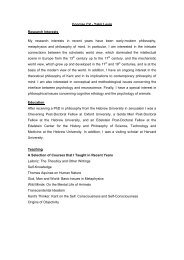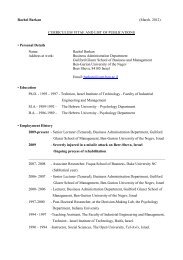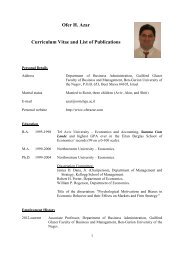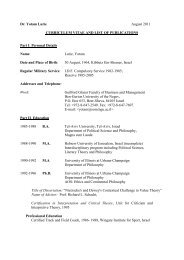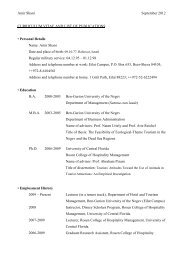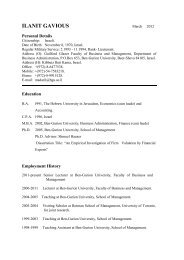cover 2006
cover 2006
cover 2006
You also want an ePaper? Increase the reach of your titles
YUMPU automatically turns print PDFs into web optimized ePapers that Google loves.
Chicxulub, an enormous buried<br />
crater on Mexico’s Yucatan<br />
Peninsula. For several years, the<br />
meteorite theory of extinction was<br />
unchallenged.<br />
About two years ago,<br />
Abramovich’s Ph.D. supervisor at<br />
Princeton University, Prof. Gerta<br />
Keller, rocked this theory. Drilling<br />
in the Mexican crater, Keller’s group<br />
dated the impact to the last 300,000<br />
years of the Cretaceous period,<br />
meaning toward but not at the K-T<br />
boundary.<br />
“This means that the meteor<br />
couldn’t have been the only killing<br />
mechanism,” explains Abramovich.<br />
“It may have been one trigger, but<br />
there were most likely other largescale<br />
events of disastrous<br />
proportions, like severe greenhouse<br />
warming, that took place a few<br />
hundred thousand years before the<br />
K-T extinction.”<br />
Apparently, the dinosaurs were<br />
in trouble long before the K-T<br />
boundary. Using planktic<br />
foraminifera, Abramovich points<br />
out several disasters she believes<br />
contributed to their downfall. By<br />
analyzing the skeletons of the<br />
microfossils, she gleans information<br />
about the oceans’ temperature<br />
millions of years ago. This way, she<br />
has identified a worldwide heating<br />
trend that preceded the K-T<br />
boundary by some 450,000 years.<br />
This warming, holds Abramovich,<br />
corresponds with intensive volcanic<br />
activity in India. At the Deccan traps,<br />
in western India, volcanoes released<br />
huge quantities of lava, creating<br />
greenhouse gases and ultimately<br />
leading to extreme warming on a<br />
global scale.<br />
Deciding to investigate this idea<br />
in different locations around the<br />
world, Abramovich and her team<br />
have been focusing on the last<br />
million years at high resolution.<br />
They examined samples from every<br />
10cm of earth, which corresponds<br />
to 10,000-year periods. Counting the<br />
number of species of planktic<br />
foraminifera, they found fewer and<br />
dwarfed versions of different species<br />
during the warming periods. “This<br />
is definitely due to warming – it<br />
occurred at the same time. The<br />
animals entered a survival mode,<br />
which enabled them to live,” says<br />
Abramovich, who is now using<br />
isotope analysis to further probe the<br />
microfossils.<br />
The Negev location of BGU has<br />
been a boon to Abramovich’s<br />
research. She explains that every<br />
major geological period has a ”type<br />
locality.“ Paleontologists work by<br />
cutting into the earth and examining<br />
layers of rock, each of which<br />
represents a specific period. Wide<br />
layers are desirable, as they grant<br />
researchers detailed descriptions of<br />
the period in question. Tunisia<br />
provides the best type locality for<br />
the K-T period worldwide – nine<br />
meters representing the last 300,000<br />
years of the Cretaceous era, the<br />
Maastrichtian period. The Negev<br />
runs a close second, with its eight<br />
meter-deep layer for the same epoch.<br />
Examining samples from this nextto-ideal<br />
locality, Abramovich and<br />
student, Shlomit Yovel, compare<br />
results to those from around the<br />
world.<br />
Today, after two decades of<br />
scientific battle over the extinction<br />
of the dinosaurs, there are still no<br />
obvious victors. While scientists<br />
have engaged in huge international<br />
efforts and gathered vast data bases<br />
of geo-biological-paleontological<br />
evidence, the answer is still not clear.<br />
The world of the K-T mass<br />
extinctions is so distant in time, so<br />
immense and complex, that the<br />
cause of the extinctions remains<br />
shrouded in mystery. For now,<br />
armed with her revealing planktic<br />
foraminifera, Abramovich remains<br />
firmly devoted to un<strong>cover</strong>ing the<br />
truth.<br />
BGU NOW 17



